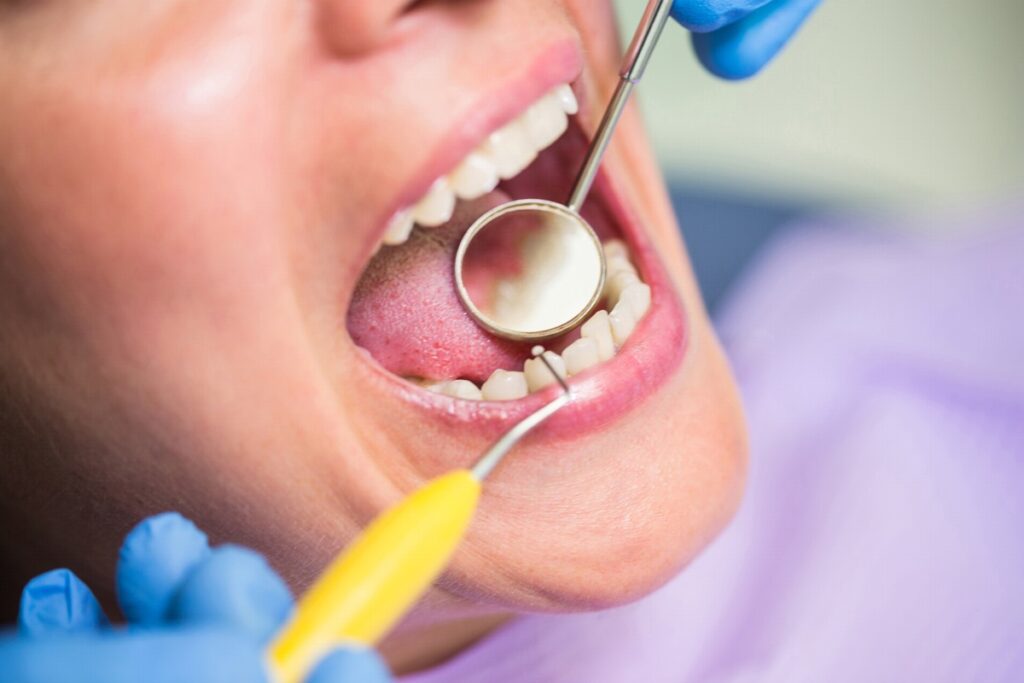Gum Diseases
- Home
- Our Treatments
- Periodontology
- Gum Diseases

What Is Gum Disease?
Gum disease is the inflammation and infection of the tissues surrounding and supporting the teeth. When bacteria penetrate the gum tissue, the immune system responds to protect the body, initiating inflammation. This causes the gums to become red, swollen, and prone to bleeding.What Are the Types of Gum Disease?
The types of gum disease are as follows:- Gingivitis: Gingivitis is a mild inflammation of the gums. It usually develops due to plaque accumulation and poor oral hygiene. Gum inflammation may present with symptoms such as redness, swelling, tenderness, and bleeding. Gingivitis can usually be treated before it progresses to gum recession or more serious gum diseases like periodontitis.
- Periodontitis: This occurs when gingivitis progresses. Dental plaque extends below the gum line, damaging the gums and surrounding tissues. In this condition, the gums recede further, teeth become loose, and may even be lost. If untreated, periodontitis can lead to tooth loss.
- Gingival Hypertrophy or Hyperplasia: Gingival hypertrophy or hyperplasia is the abnormal overgrowth of the gums. This condition can interfere with normal gum function, make brushing or flossing difficult, and cause aesthetic concerns.
- Peri-implantitis: Peri-implantitis is the inflammation and bone loss around dental implants. It can occur due to neglecting implant care or incorrect implant placement. Peri-implantitis may result in implant failure or loss.
What Factors Cause Gum Disease?
The factors causing gum disease include poor oral hygiene, smoking, genetic factors, hormonal changes, stress, unhealthy eating habits, and the effects of certain medications.What Are the Symptoms of Gum Disease?
The symptoms of gum disease include:- Swollen gums
- Gums that are bright red, dark red, or dark purple in color
- Sensitivity when touching the gums
- Bleeding
- Pink color on the toothbrush after brushing
- Spitting blood while brushing or flossing
- Persistent bad breath
- Loose teeth
- Pain while chewing
- New gaps resembling black triangles forming between teeth
- Gum recession causing teeth to appear longer than normal
What Can Be Done to Prevent Gum Recession?
To prevent gum recession, the following measures can be taken:- Visit the dentist regularly every six months for oral and dental health check-ups.
- Maintain a regular brushing routine for teeth and gums.
- Brush teeth correctly using proper techniques.
- Use a toothbrush with soft bristles.
- Have dental scaling performed regularly at intervals recommended by the dentist.
- Identify and take precautions against age-related tooth and tissue loss.
- Quit smoking.
- Maintain a healthy and balanced diet.
- Gum recession can also be managed with medications and mouth rinses.
Appointment Form
Please fill out the form below, and our team will contact you shortly.
Why Reyhan Arıkan?
We bring together knowledge, experience, and technology.
Your Smile Is Our Priority
With our experienced team, we are here for you to achieve healthy and beautiful smiles.
Reliable Dental Health
We add value to your smiles with over 20 years of experience and a modern approach.
Happy Patients
The satisfaction of thousands of our patients is our greatest achievement.
Our doctors
Our doctors are always by your side.
At our clinic, we offer you the most up-to-date treatment methods with our physicians, each of whom is an expert in their field. We are here to help you achieve a healthy and aesthetic smile with our experience, care, and modern technology.

Reyhan Arıkan
Dentist

Elif Seymen
Dentist

